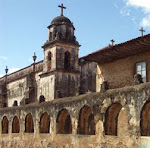Dr. Klaus Willeke and Dr. Audrone Willeke have visited Patzcuaro a number of times and always happily return. This year they planned to be here for the Noche de Muertos celebrations. The following is a look at Patzcuaro through their eyes, from an email with their permission:
Dear friends,
About 1 ½ weeks ago, we arrived in Patzcuaro, in the Mexican state of Michoacan. We rented a comfortable house for a month in the historical heart of this small colonial city that is surrounded by Purepecha (Tarascan) indigenous villages, mostly on Lake Patzcuaro. We would like to share a few vignettes of our time here.
Patzcuaro, in the Purepecha language, means “portal to the world of darkness.” It was founded by the Spanish in the 1530s, on a site sacred to the Purepecha. The mix of pre-Columbian and Christian beliefs is most evident in the celebration of the “Dias de los Muertos” on November 1 and 2. Before the celebrations started, we spent a day each in several pueblos, observing the preparations and talking to the villagers about it. In the Purepecha belief, the spirits return during the night vigil and commune with the family. The purpose of many of the rituals is to help the spirits find their way back. We spent time on Isla Janitzio in Lake Patzcuaro, in Tzintzuntzan with its impressive pre-Columbian pyramids, and in Erongaricuaro. The latter has a pleasant patio café called Red Star Café, run by a leftist commune. At the entry was an altar for Trotzky who was assassinated in Mexico City. We enjoyed talking to Charles, an American member of the commune, who wore a t-shirt with a picture of Rosa Luxembourg. The food was good, not revolutionary.
On the morning of November 1, we took a collectivo (a small van that runs a route and picks up anybody who flags it down) to the village of Ihuatzio and went to the local cemetery. The graves were decorated with flowers, candles, and pre-Columbian symbols, also baskets of food for the deceased. Since that morning was the vigil for deceased small children (angelitos), the offerings included toys and sweets that the deceased would have enjoyed. The brothers and sisters sat around the tombs with their mothers for hours. We were the only outsiders but felt welcome. Families shared bread in the form of a small child, and also fruits, with their neighbors and with us. In talking to them at length, we were touched by their stories.
Daytime vigil for angelitos (little angels), the souls of departed children, Ihuatzio. Audra accepts food that is offered. (Willeke photo)
That night, we went to several village cemeteries on or near Lake Patzcuaro. The most memorable was the hill village of Arocutin that we reached about 2 a.m., wearing many layers against the cold night air at an altitude above 7000 feet. A full moon illuminated the cemetery, hazy from many candles and small bonfires. The families were huddled around the bonfires, next to the graves of their loved ones. Most of the people sit there all night, wrapped in rebozos (shawls) against the cold. It is beautiful, eerie, and mystical: hundreds of candles faintly light the graves, the offerings, the marigold flowers, and above all, the faces.
That night, we went to several village cemeteries on or near Lake Patzcuaro. The most memorable was the hill village of Arocutin that we reached about 2 a.m., wearing many layers against the cold night air at an altitude above 7000 feet. A full moon illuminated the cemetery, hazy from many candles and small bonfires. The families were huddled around the bonfires, next to the graves of their loved ones. Most of the people sit there all night, wrapped in rebozos (shawls) against the cold. It is beautiful, eerie, and mystical: hundreds of candles faintly light the graves, the offerings, the marigold flowers, and above all, the faces.
Noche de Muertos (night of November 1st to 2nd) vigil at Arocutin cemetery. (Willeke photo)
In the meantime, back in Patzcuaro, thousands of young people from Mexico City and elsewhere congregated in the plazas and streets, celebrating in their own, noisier way. All week long, the city offered a program of cultural events, free to all, under the unique title “La Muerte Tambien Se Divierte" (Death Has Fun, Too). We attended a concert of classical music in an old church decked out with flowers. In a former monastery from the 1600s we heard Gregorian Chant sung by a group dressed as monks. At the opening of an art exhibit, we took special note of a painting with Superman displayed with his cape, but all bones underneath, entitled Super Muerto. Another showed Marilyn Monroe kicking up her skirt to show the skeleton underneath. We did not buy either of the two paintings.
We are back among the living and hope that you are enjoying life as well.
Klaus and Audra Willeke
In the meantime, back in Patzcuaro, thousands of young people from Mexico City and elsewhere congregated in the plazas and streets, celebrating in their own, noisier way. All week long, the city offered a program of cultural events, free to all, under the unique title “La Muerte Tambien Se Divierte" (Death Has Fun, Too). We attended a concert of classical music in an old church decked out with flowers. In a former monastery from the 1600s we heard Gregorian Chant sung by a group dressed as monks. At the opening of an art exhibit, we took special note of a painting with Superman displayed with his cape, but all bones underneath, entitled Super Muerto. Another showed Marilyn Monroe kicking up her skirt to show the skeleton underneath. We did not buy either of the two paintings.
We are back among the living and hope that you are enjoying life as well.
Klaus and Audra Willeke





1 comment:
I missed this celebration this year, I hope to be there soon!!
Post a Comment